Qualcomm Snapdragon 820 Gets Next-Generation Adreno 530 GPU, DSLR-Quality Photography
Qualcomm announced its Adreno 5xx GPU architecture as well as a 14-bit "Spectra" image signal processor that promises to create DSLR-quality and blur-free photography.
Adreno 5xx
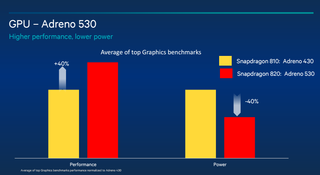
The company announced two first GPUs for this new architecture -- the Adreno 530, which will come with the Snapdragon 820 chip, and the Adreno 510, which will arrive in the Snapdragon 618 and 620. The Adreno 530 is 40 percent faster and uses 40 percent less power than the Adreno 430, according to Qualcomm.
The new architecture has support for 64-bit virtual addressing and allows for virtual shared memory and efficient co-processing with 64-bit CPUs. It also comes with improved power management, compositing, and compression techniques, which enable high performance on a lower power budget.
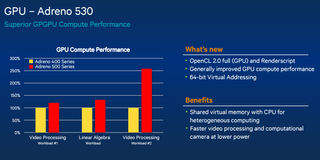
The new GPU supports OpenGL ES 3.1 with the Android Extension Pack (AEP), Renderscript, and the new OpenCL 2.0 and Vulkan standards, the latter of which minimizes driver overhead and enables better multi-threaded performance.
Adreno 5xx also supports 4k HEVC video playback at 60 fps over HDMI 2.0 to Rec. 2020 ultra-high definition (UHD) displays and TVs.
Spectra ISP
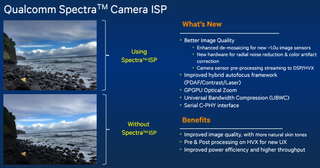
Spectra is a 14-bit dual-ISP that supports up to three simultaneous cameras (one in the front and two on the back) and up to 25MP resolution at 30 fps with zero-shutter lag. The new ISP also comes with a hybrid autofocus system (likely phase detection AF combined with contrast-based AF), along with multi-sensor fusion algorithms for next-generation computational photography.
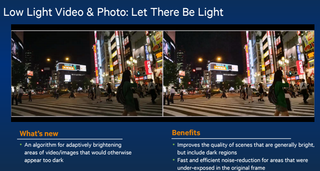
As smartphones use lenses that are only so big or so expensive, they are significantly more limited in how much light they can capture compared to actual DSLR cameras. Advanced computational photography is one way to sidestep those limitations and improve photos through the ever-greater computing capabilities of smartphones.
Stay on the Cutting Edge
Join the experts who read Tom's Hardware for the inside track on enthusiast PC tech news — and have for over 25 years. We'll send breaking news and in-depth reviews of CPUs, GPUs, AI, maker hardware and more straight to your inbox.
Tim Leland, vice president, product management, Qualcomm Technologies, Inc., said:
"Qualcomm Spectra ISP, together with our Adreno 5xx-class GPU, brings an entirely new level of imaging to smartphones, and is designed to allow Snapdragon-powered devices to capture ultra-clear, vivid photos and videos regardless of motion and lighting conditions and display them with the color accuracy that nature intended. In addition, as emerging growth segments such as automotive demand more immersive visual experiences, Snapdragon 820 will enable the next generation of infotainment, computer vision and advanced processing for instrument clusters," he added.
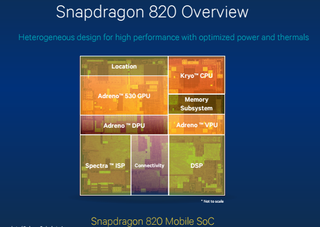
The Snapdragon 820 is expected to arrive in the first half of 2016, which will likely disappoint many who were expecting it to be in at least one of the next-generation Nexus smartphones or the Sony Xperia Z5.
Follow us @tomshardware, on Facebook and on Google+.
-
gangrel With all the issues with the 810, they need to get the 820 right. I don't need anything at this level myself, so I'm oriented more to the 618 or 620, and possibly even the 425. We're starting to see the SoCs moving on a path a lot like CPUs...the lower-tier ones are getting to be quite capable for most purposes.Reply -
Fatal_Taco Look at these awesome high performing SoCs....Reply
And there's me, enjoying life with a mere MediaTek MTK6592. Well, at least it serves me well enough :)
I can only dream... -
MobileEditor ReplyWe're starting to see the SoCs moving on a path a lot like CPUs...the lower-tier ones are getting to be quite capable for most purposes.
True, with the rapid advances in mobile processors, even lower-tier parts offer a lot of compute capability. At this point, it seems software is lagging behind.
One of the ways mobile devices will leverage the additional performance is through neural networks. Qualcomm, for example, will be offering its new Zeroth platform with the Snapdragon 820. This will include behavioral analysis to learn how you use your device, so it can present you with relevant content when you need it. Another feature Qualcomm demoed at SIGGRAPH is an intelligent camera feature that uses neural networks and heterogeneous computing for real-time object detection. This is all done locally on the device without sending any data to the cloud, and it makes searching your photo library easier by automatically labeling photos with the objects it recognizes. Other OEMs such as ZTE are also adding similar features to its devices. In the future, there will really be "smart" phones.
- Matt Humrick, Mobile Editor, Tom's Hardware -
de5_Roy can someone clear this up for me: qualcomm's claiming DSLR quality is misleading because a smarphone will lack the lens department. the ISP can do only so much.Reply -
MobileEditor Replycan someone clear this up for me: qualcomm's claiming DSLR quality is misleading because a smarphone will lack the lens department. the ISP can do only so much.
You are correct. The laws of physics prevent smartphone cameras from equaling DSLR performance. Post-processing can improve images to some extent, but ultimately they are limited by the amount of light they can gather.
- Matt Humrick, Mobile Editor, Tom's Hardware -
gangrel Matt, I agree with you in re leveraging in neural nets and the like...but our phones don't have to worry about that. :) I have heard of issues trying to game on a lower-end phone...not my espresso shot. But most definitely, I can see differences browsing between my original Nexus 7 and my Nexus 9, and browsing occasionally is possible. Or in weather apps...AccuWeather has radar maps. They load and play SO much more smoothly on the 9. Weather app is one that would go onto a phone, and the radar map playback is important to me. I'm still hoping to see the next-gen 425 and 618 phones. They may be Q4 2015, but US options especially may be limited until as late as Q2 2016.Reply -
Virtual Reality Apart from beautiful graphics and camera result, Snapdragon 820 will be highly recommended for virtual reality apps.Reply
(virtualrealitytimes . com) -
CyberAngel This CPU is hot,Reply
but because of the reduced power usage it runs cool
which is cool
(burned by 810) -
gangrel AFAIK no one's got heat data on the 820; you're thinking of the 810. The two are night and day different.Reply
Most Popular



